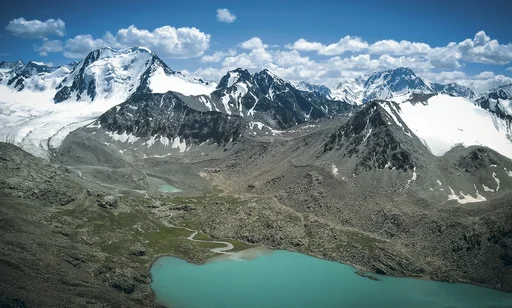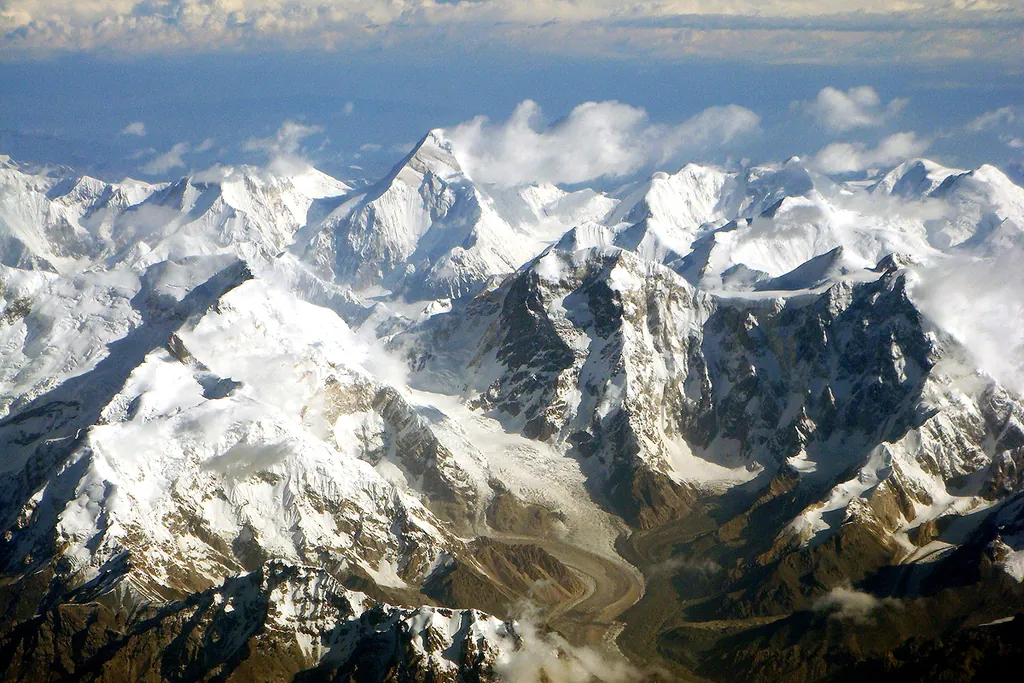Forgotten Rivers and Mountain Peaks: A Journey Along the Southern Shore of Issyk-Kul is a three-day tour that immerses you in the unique natural beauty of Kyrgyzstan.
- Duration: 3 days.
- Price: from 1300$ 1000$ for group
- Group size: Small group tour

The Tien Shan is a magnificent mountain system in the heart of Central Asia, a significant portion of which lies within Kyrgyzstan. The mountainous terrain covers much of the country, shaping its climate, nature, and way of life. The Tien Shan is among the highest mountain systems on the planet - over thirty of its peaks soar above 6000 meters. It is no coincidence that its name translates as “Heavenly Mountains” - since ancient times these ranges have inspired awe among the peoples living in their vicinity.
The Tien Shan stretches approximately 2500 km from west to east across the territories of Kyrgyzstan, China, Kazakhstan, and Uzbekistan. The mountain width reaches 300-400 km. In Kyrgyzstan lie the central and western parts of the Tien Shan - making it convenient to reach many key areas from Bishkek, Osh, and the shores of Issyk-Kul. The highest summit of the entire Tien Shan is Jengish Chokusu (Victory Peak, 7439 m) on the Kyrgyz-Chinese border. It is the northernmost “seven-thousander” in the world, renowned for its difficulty and harsh climate. The legendary Khan Tengri (7010 m with its ice cap) is the second highest peak in the system. Its name means “Lord of the Sky,” reflecting the sacred role of this summit in Turkic traditions.
From a geological standpoint, the Tien Shan is of ancient origin. Its foundation was laid around 400 million years ago in the mid-Paleozoic era. The northern ranges formed through the Caledonian orogeny, and others in the Hercynian period. Since then, the mountains have undergone multiple uplift and erosion phases. The modern Tien Shan landscape emerged during the Alpine orogeny (Late Neogene). This process continues today - the region is highly seismic and tectonically active. The ranges are mainly composed of Paleozoic crystalline rocks, with extensive intermontane basins of sedimentary deposits between them. The Tien Shan’s subsurface is rich in minerals: mercury, antimony, lead, zinc, oil, and more have been mined here since antiquity.
The mountain climate is continental and extremely varied. The foothills in the north and west are semi-desert and steppe - hot and dry in summer, relatively mild in winter. With altitude, the climate changes sharply: at 1500-2500 m slopes are covered by coniferous forests (mainly Tian Shan spruce), above 3000 m alpine meadows prevail, transitioning to cold tundra and permanent snow. By late summer, the peaks often receive fresh snow, and the only truly warm month in the highlands is July. The total area of Tien Shan glaciers is vast - about 7300 km². The largest is the South Inylchek Glacier, some 60 km long, straddling the Kyrgyz border and feeding the Saryjaz River. These perennial ice masses play a critical role: in summer, the melting Tien Shan glaciers supply water to the entire region. From them originate the Naryn (main tributary of the Syr Darya), Chu, Ili, Kyzylsu, Tarim, and dozens of other rivers. The mountains also hide beautiful high-altitude lakes - from the vast, unique Issyk-Kul to small glacial lagoons - that store water and moderate the climate of adjacent valleys. However, in recent decades climate change has taken its toll: glaciers are melting faster. Over 70 years, Kyrgyz glaciers have shrunk by 16%, and scientists warn of future water shortages. For these reasons, the western Tien Shan, with its unique ecosystems, was inscribed in 2016 on the UNESCO World Heritage list by Kyrgyzstan, Kazakhstan, and Uzbekistan - to protect rare species and precious water resources.
The Tien Shan system is complex and divided into several regions - Northern, Western, Central, Inner, and so on. Below are the main ranges located within Kyrgyzstan:
Kyrgyz Range (Kyrgyz Ala-Too) - extends eastward from the Kazakh border along the Chu Valley, forming a picturesque backdrop for Bishkek. The range is about 375 km long, with peaks up to ~4895 m (Semyonov Peak). Northern foothills are arid steppe, while southern slopes are more humid. The Kyrgyz Range houses the Ala-Archa National Park, popular among tourists and climbers. It is famed for accessible glaciers and peaks such as Uchitel and Korona.
Kungey Ala-Too - the northern mountain belt bordering Lake Issyk-Kul. Its name means “sunny mountains” (facing south) - their southern slopes indeed bask in sunlight over the lake. The range runs parallel to the shore for ~280 km, reaching up to 4771 m (Chok-Tal Peak). Rich spruce forests grow here, and passes offer panoramic views over Issyk-Kul. Popular treks include routes to Ala-Kul Lake and the Barskoon Waterfall.


Too-Ashuu Ala-Too - the range south of Issyk-Kul (“shady side,” opposite Kungey). Too-Ashuu is higher and more massive: its peaks reach 5216 m (Karakol Peak). The eastern section connects to the Central Tien Shan and glacier fields. At the junction of Too-Ashuu and Kakshaal is the vast Inylchek Glacier. Too-Ashuu boasts diverse landscapes - from the red cliffs of Jeti-Oguz to the alpine meadows and forests of Jyrgalan. Hidden here are lakes and hot springs popular with travelers.
Kakshaal-Too - the southernmost and highest range in Kyrgyzstan, forming the Chinese border. Here stand the Tien Shan’s tallest peaks - Victory Peak (7439 m) and Khan Tengri (6995 m). The range is about 582 km long, extending along the border into China’s Tengri-Tag. Its northern slopes descend into Kyrgyz valleys (Naryn River and Chatyr-Kul Basin), the south to China’s deserts. Kakshaal-Too is marked by sharp summits, vast glaciers, and harsh climate. The Victory and Khan Tengri area, known as the Central Tien Shan, remained remote and little studied until modern times; today it is renowned as a high-altitude climbing mecca.
Fergana Range - to the northeast of the famous Fergana Valley, forming the southwestern boundary of the Tien Shan. Stretching ~225 km, it is lower (up to ~4940 m) but very scenic and biologically rich, with dense spruce-fir forests and rare flora and fauna. Protected reserves here preserve mountain lakes and forest ecosystems.
Talas and Chatkal Ranges - key chains of the Western Tien Shan, beginning in Kyrgyzstan and continuing into Uzbekistan. Peaks reach 4500 m. These mountains are known for mild climate and rich nature: rivers flow through deep green gorges, there are waterfalls and blooming alpine meadows. The Western Tien Shan is on the UNESCO World Heritage list for its unique relict forests and high biodiversity. It appeals to eco-tourists with its accessibility and numerous routes.


The Tien Shan mountains have been known to local peoples since ancient times, yet remained terra incognita to science for centuries. Ancient Chinese chronicles referred to them as “Heavenly Mountains” and regarded them as the western border of the inhabited world. Legends tell of Taoist sages seeking immortality plants here in the Middle Ages. During medieval times, branches of the Silk Road traversed Tien Shan passes: caravans linked the Fergana Valley to Kashgar via Torugart and Irkeshtam Passes, leaving tales of snow-bound monasteries and hidden treasures. Systematic scientific study of the region only began in the 19th century.
The Russian geographer Pyotr Semyonov was the Tien Shan’s scientific pioneer. In 1856-57 he led an expedition into Kyrgyz mountains, charting peaks and lakes unknown in Europe. For his contributions, he was honored with the surname “Tian-Shansky.” Through his eyes, the world first learned of the vast Inylchek glaciers and that Khan Tengri was not a volcano - as once believed - but a majestic pink marble pyramid. Slightly earlier, in the 1840s, British explorer Thomas Atkinson traversed Central Asia’s mountains seeking volcanoes and exotic landscapes, publishing his adventures in London in 1858 and igniting European interest in the “unknown Tien Shan.” In the late 19th century, Swedish explorer Sven Hedin also mapped and clarified the locations of the highest peaks.
In the 20th century, Soviet scientists and travelers continued Tien Shan research. Expeditions of geologists, botanists, and hydrologists mapped the ranges. Mountaineers began scaling snow-capped summits. In the 1930s, the USSR launched “alpiniads” - mass ascents - and the Tien Shan became a premier venue. M. Pogrebetsky and his team made the first ascent of Khan Tengri in 1931. Victory Peak remained unconquered for decades until a Soviet team led by Vitaly Abalakov successfully reached its summit in 1956, after several tragic attempts. Climbing Khan Tengri and Victory Peak earned mountaineers the prestigious “Snow Leopard” title. During Soviet times, alpine camps and mountain bases (Ala-Archa, Karavshin) trained generations of climbers. By the late 20th century, almost all major Tien Shan summits had been explored and ascended, though some remote Chinese peaks remain unclimbed. Today, the Tien Shan attracts both professional climbers and scientists conducting crucial glaciological studies amid global warming.

For Kyrgyzstan, the Tien Shan is a natural treasure trove and a “water tower.” Most of the country’s rivers originate in its snow and glaciers. Spring and summer meltwaters fill the Naryn, Chu, and Talas rivers, supplying water to millions in the valleys and irrigating farmland across Kyrgyzstan, Uzbekistan, and Kazakhstan. Mountain lakes regulate climate and provide fresh water. Issyk-Kul, the largest lake in Kyrgyzstan, sits within the Tien Shan and moderates the local climate - warming winters and cooling summers. Its mineral-rich waters have long been considered healing; Issyk-Kul is rightly called the “Pearl of the Tien Shan” and is a popular resort destination.
The array of elevation zones yields rich flora and fauna. Lower slopes feature dry steppes and sparse woodlands; mid-slopes host coniferous forests of Tien Shan spruce. Above the treeline (around 3000-3200 m) lie alpine and subalpine meadows, carpeted in summer with edelweiss, poppies, and globeflowers - traditional summer pastures (jayloo). In the highest regions, only lichens and a few cold-adapted plants survive. The animal kingdom is equally rich: ibex, argali, red deer, brown bears, lynx, and the elusive snow leopard (irbis), emblematic of Kyrgyz conservation efforts, roam these mountains. Eagles and bearded vultures nest in cliffs, while marmots, partridges, and mountain finches inhabit meadows. To protect these fragile ecosystems, numerous reserves and national parks have been established.

The Tien Shan holds a special place in Central Asian cultures and worldviews. Its names reflect this sacred role. In Chinese, “Tian Shan” means “Heavenly Mountains,” and in Kyrgyz one variant is “Tengir-Too” - “Mountains of Tengri, God of the Sky.” Ancient Turks and Mongols practiced Tengriism - the cult of the eternal sky - believing the supreme deity Tengri dwells atop the world’s highest peak. Khan Tengri was revered as the Kyrgyz Olympus, the abode of the sky god, to whom sacrifices and prayers were offered. Legends say no mortal dared ascend this sacred summit; on moonless nights ethereal lights gather at Tengri’s throne.
Many legends revolve around Khan Tengri. Its secondary name, “Kan-Too,” or “Blood Mountain,” stems from a tale that when a great khan died, his blood stained the snow red. Even today at sunset the marble slopes blaze crimson until darkness fully falls. Such sights fueled myths of the mountain’s supernatural essence.
Virtually every corner of the Tien Shan has its own lore. For example, Kyrgyz legends say that Issyk-Kul once did not exist until the hero Tien Shan’s wife, Issyk, was abducted by an evil sorcerer. In his rage, Tien Shan fought the sorcerer, and in his defeat the sorcerer cursed Issyk to become water, plunging underground and forming the lake. Tien Shan himself turned into the surrounding peaks. Their children became the rivers that flow eternally, linking them to the mountains. Such folktales explain the origins of Tien Shan and Issyk-Kul in poetic terms.
Another Issyk-Kul legend speaks of a sunken monastery holding the relics of the Apostle Matthew on its northern shore - once dismissed as myth, underwater archaeologists in the 2000s discovered submerged ruins here. Timur the Lame’s armies are said to have counted stones on a pass called Santash - “counting stones” - constructing piles on the way back to tally losses, giving the pass its name. These stories blend history and myth, melding religious motifs with collective memory.
For the Kyrgyz themselves, the Tien Shan has always been a spiritual home. Sacred sites abound: on slopes and near springs, simple shrines of tied cloth strips (wish ribbons) pay homage to mountain spirits. The Manjyly-Ata valley on Issyk-Kul’s south shore - named after a Sufi saint - is revered as a holy place, where pilgrims seek healing in its mineral springs. Thus, Tengriist and Islamic traditions intertwine here. Each year, thousands of pilgrims visit Manjyly-Ata, believing in the curative power of its waters.
Mountain peaks also have guardian spirits. In the Talas Ala-Too elders tell of the “Tien Shan Maiden” - a mountain goddess who appears to lone travelers on the trail. One legend says those who see her learn all the world’s secrets; another warns that men who encounter the Maiden in white will not live long. Despite ominous tales, adventurers seek her out, exploring wild gorges. Such myths emphasize the Tien Shan’s sacred mystery. The epic “Manas,” central to Kyrgyz culture, also begins with Tien Shan landscapes, praising its expanses where the hero was born. The “Heavenly Mountains” are thus woven into ethnic identity, folklore, and spiritual life in Kyrgyzstan.

Today the Tien Shan is one of Kyrgyzstan’s greatest assets and a true paradise for mountain tourism enthusiasts. Opportunities abound: mountaineering, trekking, skiing, mountain biking, horseback trails, paragliding - the list goes on. A special charm of Kyrgyz Tien Shan is its low population density and relatively wild nature. Unlike the Alps or other commercialized mountain resorts, here there are no crowds - just pristine openness. At the same time, essential infrastructure exists: mountain huts and yurt camps on popular trails, professional guides are available, and gear can be rented in major towns.
Climbing enthusiasts flock to Kyrgyzstan to test themselves on legendary peaks. The most experienced head to the foot of Khan Tengri and Victory Peak. In summer, the South Inylchek area hosts an international base camp with helicopter access - expeditions to these seven-thousanders begin here. These routes are technically and physically demanding, with Victory Peak considered one of the world’s most dangerous. Yet many climbers from around the globe have inscribed their names in its history. Those not ready for the summit can trek to base camps - treks to Inylchek offer stunning panoramas of Tengri peaks and a glimpse of the “Shimmering Lake” Merzbacher within the glaciers.
More accessible climbs and technical routes are found around Karakol and Ala-Archa. In Ala-Archa Gorge (an hour from Bishkek), alpine camps and training programs allow novices to make their first summits - such as Uchitel Peak (4525 m) - under instructor guidance. The Karavshin and Aksu regions in southern Kyrgyzstan boast sheer granite walls - a climber’s dream. The Pamir-Alay, while not strictly Tien Shan, often feature in combined tours, offering 5000+ m ascents. Thus, every taste and skill level finds a route in Kyrgyzstan.
Trekking and hiking are equally varied. Dozens of routes span the country - from easy day walks to challenging pass crossings. Popular treks around Issyk-Kul include the Teleti Pass route from Jeti-Oguz to Ala-Archa, the Ala-Kul Lake trek (3532 m) descending to the Altyn-Arashan valley, and many others.
In winter, the Tien Shan still awakens - several ski resorts operate in Kyrgyzstan. The most famous is Karakol on Issyk-Kul’s eastern shore, with pistes of all levels and modern lifts. Near Bishkek, base areas like Chunkurchak, ZIL, and Orlovka welcome skiers. For thrill-seekers, heliski tours are offered - off-trail descents by helicopter drop. Thanks to frequent clear skies, winter recreation here is exceptional.
To immerse in mountain culture, tourists can stay in authentic nomad yurts. Yurt camps around Issyk-Kul and Son-Kul invite visitors to live in traditional dwellings. Such ethno-tour programs foster deeper connections to nomadic heritage, nature reverence, and age-old hospitality.
Thus, the Tien Shan in Kyrgyzstan is a world unto itself - uniting unique nature, rich history, and culture. The Heavenly Mountains nourish the nation with their waters and inspire legends and feats. Today they welcome travelers from around the globe. Here everyone - from scholars to romantics, athletes to photographers - finds their treasure. Whether conquering a formidable peak, enjoying a quiet evening by a mountain lake, or sharing stories with a herdsman by the fire, the Tien Shan gifts unforgettable experiences and a love that endures. It is said that one who sees dawn in Kyrgyz mountains leaves a piece of their soul behind and will yearn to return. The Heavenly Mountains of Kyrgyzstan are truly a source of national pride and an incomparable natural heritage.
Forgotten Rivers and Mountain Peaks: A Journey Along the Southern Shore of Issyk-Kul is a three-day tour that immerses you in the unique natural beauty of Kyrgyzstan.
Visit two pearls of Kyrgyzstan in 1 day on a car tour
Visit the Valley of the Seven Bulls, see Issyk-Kul and relax in the thermal springs
This route combines the picturesque mountain canyons of Kok-Moinok, Lake Issyk-Kul, the taste of national cuisine and a trip along one of the most beautiful roads in the country – the Boom Gorge.
In 3 days we will travel around Lake Issyk-Kul. We will spend two days in the city of Karakol, devoting them to skiing at the ski resort. And we will also relax in the thermal springs!
Skiing, mountains, and the winter atmosphere of Kyrgyzstan. A one-day ski trip to Orlovka – skiing near Bishkek
Experience all the beauty of Kyrgyzstan's nature behind the wheel of a comfortable and daring BMW F650GS tour enduro. These impressions are worth any money and will never be forgotten.